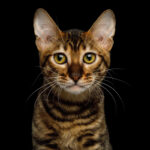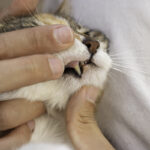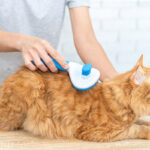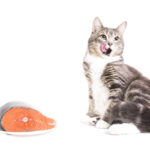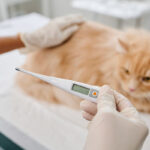Eyes are the most attractive features of the face whether it is a human or animal. If there is some problem with the eyes, it would be very irritating and worrisome. Well, just like humans, cats also suffer from various eye infections like Cat Eye Discharge.
Eyesight is extremely important and precious to everyone as we see everything with those eyes. What if you notice an unusual Eye Discharge in Cats? Eye discharge in cats may happen for various reasons ranging from a simple cold to complicated diseases.
Though an occasional eye discharge in cats may not be a huge concern, a long-term and chronic discharge from eyes in felines is an addressable issue. Get to know more about the causes, symptoms, and treatment for eye discharge in cats.
Learn more about when to contact a vet and how can you help your feline companion treat eye discharge at home through this in-depth guide.
Contents [hide]
- Eye Discharge in Cats
- Types of Eye Discharge
- Common Causes of Cat Eye Discharge
- Signs and Symptoms
- When to Worry about Your Cat’s Eye Discharge?
- How to Identify Your Cat’s Eye Problems At Home?
- Can We Treat Eye Discharge At Home And How?
- Home Remedies and Home Care Tips for Eye Discharge
- When Vet Help Is Needed?
- How Vet Diagnoses Eye Discharge in Cats?
- Treatment For Cats Eye Discharge
- Recovery
- Prevention of Eye Discharge in Cats
- Conclusion
Eye Discharge in Cats
Your feline friend’s eyes will be generally bright and clear. When you find such bright eyes turned a little gunky, it would be a worrisome thing for the pet parents. Due to severe irritation, your cat may start rubbing their face against the couch or a rug.
If you find your cat’s eye is discharging continuously then, you must assume it to be something wrong. It’s quite common for cats to have mild discharge in the corner of the eyes occasionally. What if the Eye Discharge in Cats is severe? It’s a situation to be concerned about.
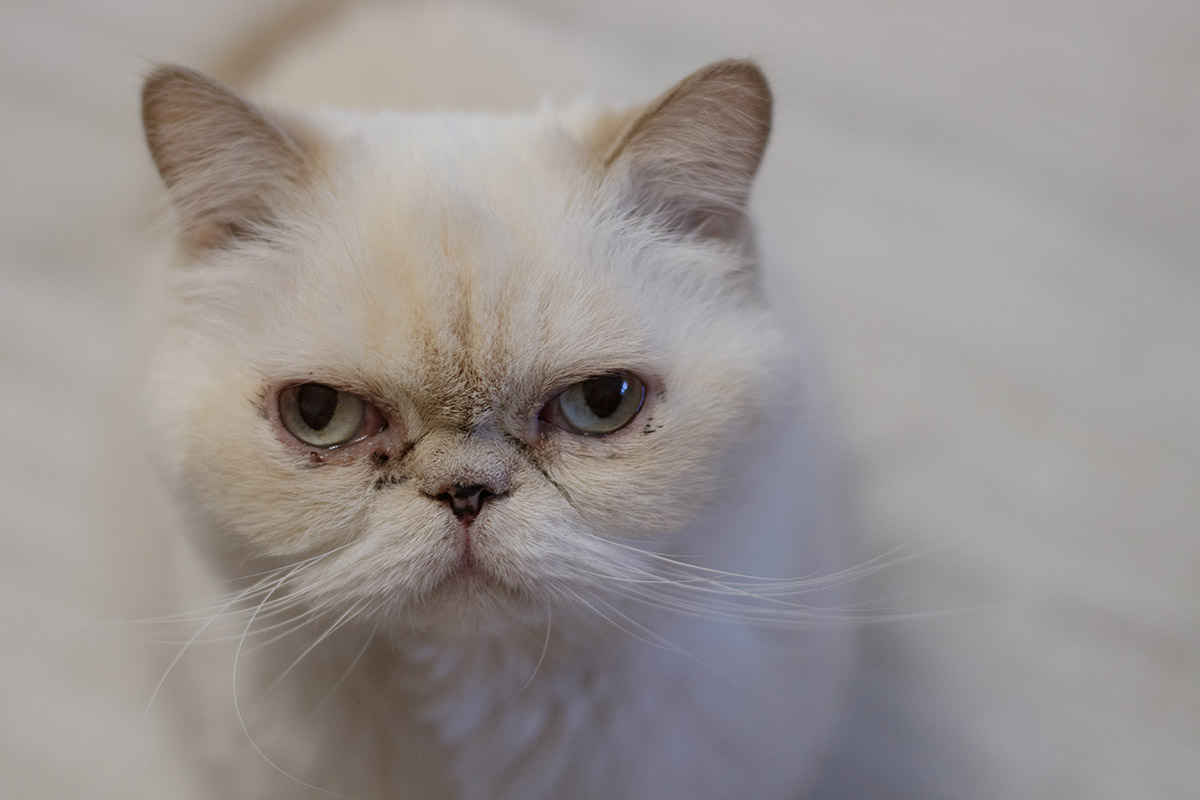
Eye discharge in cats could be a sign of infection or a health condition that must be addressed immediately with a vet. Eye Discharge is an overflow of tears from the eyes. It is otherwise referred to as Epiphora. In general, a slender layer of tears is produced from the tear ducts to keep the eyes moist and free from dust and debris.
The excess tears or fluid produced will be drained into the nasolacrimal ducts [tear ducts]. These ducts are situated in the corner of the eye beside the nose. The drained tears will go back to the sinuses and move down through the throat. Eye Discharge is caused by excessive production of tears or inadequate drainage of tears from the tear ducts.
Types of Eye Discharge
If you identify the type of eye discharge, it helps you understand the underlying health condition of your cat. There are different types of eye discharge in cats. Some of them are furnished below:
1. Cloudy Discharge
If you notice a Yellow Cat Eye Discharge, it indicates that the infection is similar to Conjunctivitis. Whenever your cat faces this kind of discharge, it appears crusty. Due to this cloudy eye discharge, your cat often closes its eyes.
2. Clear Discharge
If the cat eye discharge is clear, transparent, and watery then, it may not be a complicated infection. Clear Discharge in cats could be an indication of an irritant in the eye. It could be due to dust, debris, or allergies in the cat’s eye. In that case, you can try to wash away the irritant causing the clear discharge.
3. Green Discharge
Green Cat Eye Discharge is also referred to as bloody discharge. It is a serious symptom of some complicated diseases. It requires immediate veterinary treatment. Sometimes, green eye discharge in cats could be an indication of an ulcer in the cat’s eye. Otherwise, it could be because of an eye injury or a severe infection.
4. Brown Discharge
Cat Eye Discharge in Brown is an indication of some allergy or is even more harmful in the eyes of a cat. This kind of discharge can be seen in the inner corner of the feline’s eye and gathers alongside the nose.
5. Reddish-Brown Discharge
Cat Eye Discharge in Reddish-Brown is a sign of Epiphora. Epiphora causes wetness below the eyes of a cat, skin infection, reddish-brown staining beneath the eyes, etc. In such cats, we can observe constant wetness on the face and tears falling off the cat’s face quite often.
6. Black Eye Discharge in Cats
The black discharge that comes from the eyes in cats is referred to as eye boogers. When the cat develops a crunchy black discharge in the corner of the eye, it is considered an eye booger.
When the black pigment in the cat’s tears dries due to the moisture, a black crunchy thing forms. It usually appears like a colorless crust just the way humans get when they wake up after a long night’s sleep. However, it is not an eye discharge but just a black booger.
Common Causes of Cat Eye Discharge
Wondering what are the causes of cat eye discharge? Well, there could be various reasons behind the occurrence of eye discharge in cats. Some of the eye discharge causes lead to severe health issues like surgery and eye blindness.
It is very important to speak to the vet whenever you observe irritated eyes in your cat. In this article, let’s discuss the most common causes of eye discharge in cats. Check it out!
1. Feline Upper Respiratory Infections
One of the major causes of cat eye discharge is a feline upper respiratory infection. It is also referred to as cat flu. A variety of infections can cause flu in cats. The most common disease is feline herpes virus. Eye discharge caused due to feline upper respiratory infection appears like a sticky and pus-like discharge.
The key symptoms of this infection include constant discharge from the nose, frequent sneezing, eye discharge, etc. Once this infection attacks the cat, the immune system of the feline gets weakened and becomes extremely stressed.
A variety of viruses may cause eye discharge in cats. The types of viruses include pneumonitis, protozoa, feline calicivirus, contagious respiratory disease, herpesvirus, etc. The symptoms of this infection could range from mild to serious.
2. Conjunctivitis in Cats
Conjunctivitis also known as pink eye is an inflammation of the light pink thin membrane that usually protects the eye. This light thin membrane can be seen around the eyes of the cat. Sometimes, conjunctivitis can be caused in one or both the eyes of the cat. When conjunctivitis is attacked on the cat, the eyes of the feline appear swollen and red.
The eye discharge in cats caused by conjunctivitis looks like a clear and thick mucus. Due to this infection, the cat becomes highly sensitive to light. If your cat is suffering from fever, diarrhea, and breathing issues alongside conjunctivitis then, it could be a feline infectious peritonitis. To treat this sort of infection, the vet may prescribe drops and eye ointment.
3. Allergies
An eye allergy can also be a cause of Cat Eye discharge. Just like people, felines can also be allergic to a slew of substances that cause eye irritation and eye discharge. Cats may be allergic to various things such as dust, perfumes, cleaning detergents, Pollen from flowers, mold, etc.
Sometimes skin allergies in cats can also cause watery eyes and itching sensation. By reducing the exposure of specific allergens to your cat and making necessary adjustments, you can prevent eye discharge.
Take your cat to the vet to diagnose the underlying condition of the allergy that caused eye discharge in the cat. If required, the vet will perform necessary medical tests like standard blood tests, urine tests, temperature of the cat, etc. Once the check-up is done, the vet will prescribe appropriate medication to the cat.
4. Uveitis
Uveitis is another cause of eye discharge in cats. The inflammation in the internal structures of the cat’s eye may cause serious and painful issues in the cat referred to as Uveitis. Sometimes, this problem can lead to eye blindness in the cat if the condition is ignored or left untreated.
Uveitis is also caused due to tumors, trauma, and corneal ulceration in cats. When you take your cat to the vet, he/she will give the necessary treatment depending on the underlying condition. The vet may prescribe anti-viral, antifungal, anti-parasitic, and antibiotic medication to treat Uveitis in cats.
5. Corneal Disorders
The cornea in cats is a dome-shaped surface that conceals the front part of the eye. When the cornea in cats is injured or inflamed, it leads to corneal disorder in felines. Corneal Disorders in cats include inflammation, increased eye blinking of the cat, cloudiness, excessive tear production in cats, etc.
6. Dry Eyes
Dry eyes are referred to as Keratoconjunctivitis Sicca. Dry eye in cats is usually caused due to a chronic lack of tear production. If this condition is left untreated, it could lead to an inflamed cornea.
It also causes red eyes, permanent corneal scarring, and blindness in cats. Due to the absence of tears in the cat’s eye, you can witness a yellowish gunky eye discharge. The vet will prescribe eye drops or eye ointment, artificial tears, and other medicines to treat dry eye in cats.
7. Injured Cornea
Another cause of eye discharge in felines is an injured cornea. The cornea is the outer surface of the eye. When scratches are caused to the cornea, it will be very painful and it results in watery eyes.
If the infection occurs in the eye, it results in a Yellow Cat Eye Discharge. To diagnose this problem, the vet uses a special dye. If your feline companion is squinting in a single eye alongside eye discharge then, your cat requires immediate medical care.
8. Foreign Objects
Unfortunately, when a foreign object traps in the cat’s eye, it irritates leading to excessive eye discharge. Some of the foreign objects include an eyelash, a tiny leaf of grass, another cat’s claw, a thin piece of wood, etc., which may get trapped in the cat’s eye.
Instead of removing the foreign object from the eye, try to take the cat to the vet to remove the object. If you try to do it yourself, it could lead to corneal damage.
9. Blocked Tear Ducts
Blocked Tear Duct is another cause of eye discharge in cats. As the tear duct is small, it drains the common tears from the eye into the nose. If in case, the tiny tube is blocked due to some inflammation or an infection, tears from the eyes don’t drain out correctly. Instead, they spill over leading to eye discharge in cats.
In some of the cat types known as Persians and Himalayans, the facial anatomy will be different. Such cats will have flat noses that may weaken the proper tear duct drainage. Though this blocked tear duct condition isn’t complicated in cats, it could lead to serious conditions if left untreated.
Signs and Symptoms
Want to know the signs and symptoms of eye discharge in cats? In general, a healthy cat’s eyes work properly when a thin layer of tears lubricates the eyes and the additional fluid drains into the tear ducts. These tear ducts are situated within the corners of the eyes and move into the nasal cavity.
The tear ducts drain tears back to the nose and throat. If there is some damage to the tear ducts, they will get clogged leading to constant eye discharge. Eye discharge in felines differs in consistency, irritation levels, and frequency. In specific cats, eye discharge may occur on its own.
Some other cats may have eye discharge due to its underlying disease-associated symptoms. When you notice certain symptoms in your cat then, it indicates that your cat has eye discharge. There are copious symptoms of eye discharge in cats that range from mild to serious conditions.
- Eye Inflammation
- Swelling of Eyes
- Impaired Vision
- Excessive wetness around the eyes
- Redness of Eyes
- Crusty formations around the edges of the eye cause dry discharge
- Excessive Blinking
- Squinting
- Constantly rubbing the face against the surface
- Skin Irritation
- Light Sensitivity
- Cloudy and Gunky Corneas
- Reddish-brown staining beneath the eyes
- Loss of fur around the eyes
Eye Discharge may sometimes be accompanied by other symptoms of illnesses such as the following:
- Lethargy
- Sneezing
- Low Appetite
- Nasal Discharge
- Discoloration of the eye discharge changes [it may be clear in color, yellowish, greenish, reddish, etc with mucous consistency]
When to Worry about Your Cat’s Eye Discharge?
If the eye discharge in cats persists for several days and the amount of discharge is increased, it’s time to take your cat to the vet. If the eye discharge color and consistency varies i.e., from a clear color to a yellowish or greenish color, and from a liquid consistency to mucous consistency then, it’s a worrisome condition.
If there is some visible pain in your cat like excessive blinking, pawing, squinting, and extreme distress then, it’s time to worry about the cat’s situation. Immediately, you must consult your veterinarian and give proper treatment to the cat.
How to Identify Your Cat’s Eye Problems At Home?
As a pet parent, you can perform specific at-home eye examinations to identify the underlying cause of eye discharge and other eye problems in the cat. Try to examine your cat’s eyes frequently to identify the problem before they turn most complicated. Take your cat into your hands and roll down the eyelid of the cat using your fingers.
Check whether the lining is pink or not. If the eye looks completely fine without any discharge then, it is considered a healthy eye. If the eye is swollen and appears in red or white color then it’s an indication of some eye problem in the cat. Check whether the eyeballs of the cat appear healthy or not. See if there is any cloudiness in the eyeball of the cat.
Can We Treat Eye Discharge At Home And How?
Yes, we can treat Eye discharge in cats at home by flushing the cat’s eyes with water. If this method doesn’t work, you must take your cat to the vet. If your cat is suffering from an eye discharge due to conjunctivitis then, it doesn’t need treatment and clears up on its own.
Home Remedies and Home Care Tips for Eye Discharge
Exploring the Cat Eye Discharge Home Remedy? If so, you’re in the right place! Before implementing any sort of home remedies for cat eye discharge, make sure you speak to the vet.
Otherwise, a small home remedy could lead to permanent blindness in your cat if the remedy doesn’t work properly. Go through the simple home remedies and home care tips to treat eye discharge in cats.
- If your cat is suffering from a mild eye discharge caused due to some allergy or irritants, clean your cat’s eye gently using a soft warm cloth. By doing so, your cat can get some relief.
- Don’t ever try to use human eye drops on cats to treat eye discharge. Don’t use eye drops, saline solutions, or any other medication related to humans without consulting your vet.
- If in case, the eye discharge is caused by the flu then, you can try to improve the cat’s diet to enhance its immune system.
- If the eye discharge is caused due to the shape of the cat’s face, it is not possible to improve it. However, you can maintain the cat’s skin by preventing infections. Boil some water and cool down it completely.
- Dip the cotton pad in water and clean the eye discharge using the cotton pad. If eye discharge occurs for both eyes, use a fresh cotton pad for each eye. If you take your cat to the vet, he/she will suggest a wipe or solution to prevent the infections.
When Vet Help Is Needed?
Cat’s eyes are the most delicate and sensitive parts of the body. The eyes are one of the most attractive organs on the face of the cat. The mild problem of the cat may quickly turn into a serious health condition.
If the eye discharge in your cat is consistent and if the symptoms increase even after 24 hours, it’s time to speak to your vet regarding the cat’s situation. When you notice your cat is squinting, it indicates that the cat’s condition is serious and needs immediate vet help.
If the eye discharge is cloudy and has a bad smell, the problem may worsen within hours. Sometimes ocular diseases in a cat may be transmitted to humans. Hence, it is important to wash your hands before and after handling a cat suffering from an ocular discharge. Be careful while touching the face of your cat.
How Vet Diagnoses Eye Discharge in Cats?
If you take your cat to the vet for Treatment for Eye Discharge in Cats, the vet will perform necessary physical and medical examinations. By performing specific investigations, the vet will rule out the common causes of a cat’s eye discharge.
After ruling out other causes, the vet will find out the major underlying cause of eye discharge in cats. The pet parents must share as many details as possible about the condition of the cat when speaking to the veterinarian.
Make sure you tell all the symptoms of your cat to the vet apart from the eye discharge symptoms. This way, your vet will be able to narrow down the particular underlying cause of eye discharge.
When you visit the vet for the first time, the vet will thoroughly perform a physical examination. The veterinarian will check the temperature of the cat and look for any tender or sore spots on the cat’s body.
The vet may recommend a standard blood panel for the cat. Once the medical test is performed, the vet will check the report and determine the underlying cause of eye discharge in the cat.
Another precise diagnostic tool to identify the underlying cause of an eye discharge in the cat is to perform an eye examination namely Ophthalmoscope. Even, this device is used to examine the eye of humans. Through this tool, the vet will be able to check the magnified view of the cat’s eye.
During this examination, a special dye is applied to the cat which is known as a fluorescein eye stain test. During this test, harmless eye drops are applied to the cat’s eye and placed under special lights.
By doing so, the vet will be able to view the outline of the cat’s eye and see if there are any ulcers or injuries in the eye. Further, the surface of the cat’s eye is flushed using saline to remove any sort of foreign objects near the eye.
Treatment For Cats Eye Discharge
The Treatment for Eye Discharge in Cats depends on the actual cause of the problem. Sometimes, no treatment may be required for this eye discharge problem. In some cases, surgery may be required to treat a cat’s eye discharge. Several conditions may lead to eye discharge in felines.
Hence, you need to speak to the vet before giving treatment to the cat. We have explained the treatment given to each type of condition that caused eye discharge. Check it out!
- Blocked Tear Duct: If the eye discharge is consistent due to a blocked tear duct, the veterinarian will sedate the cat and insert an instrument into the tear duct to flush out the blockage. By doing so, the tears will be able to drain out more easily.
- Conjunctivitis: Dust, debris, pollen, and other irritants may cause Conjunctivitis in cats. If your cat is suffering from conjunctivitis, it can be treated using a steroid ointment. If in case, conjunctivitis is caused by a bacterial infection, the vet may prescribe antibiotic ointments.
- Corneal Disorders: To treat corneal disorders, the vet will identify the thing that’s irritating the cat’s cornea. The treatment option includes maintaining a cat’s eye clean and hygiene. Sometimes, the vet will prescribe antibiotic eye drops and antibiotic eye ointment. Antibiotic drops help in healing the eye discharge by removing loose corneal tissue.
- Feline Upper Respiratory Infection: To treat feline upper respiratory infection, the vet may prescribe necessary eye medications, antibiotics, fluids, and decongestants.
- Entropion and Dental Disease: If the cat is suffering from eye discharge due to entropion or foreign objects, and dental disease, the vet may recommend surgery to treat this problem.
- Watery Eyes: To treat this problem, the vet will give general anesthesia to the cat. Under anesthesia, the veterinarian will use plain water or saline to flush the blocked tear duct. In case, the vet finds any infection in the eye, he/she will prescribe an antibiotic eye ointment or drops.
- Dry Eyes: For dry eyes, the treatment includes ointments, eye drops, antibiotics, artificial tears, etc. Dry eye in cats may occur due to various diseases such as herpesvirus related to the immune system. To treat this condition, immune-suppressing drugs are prescribed to the cat.
- Uveitis: The vet can give precise treatment for Uveitis once he/she understands the reason behind the cause of Uveitis in cats. However, the diagnosis procedure is quite difficult. The vet will prescribe eye ointment, drops, or other medications to treat inflammation and reduce the pain.
- Swollen & Painful Eye: When the cat’s eye is painful and swollen, the vet may recommend a warm compressor to be applied to the eye. Other medications include pain-relieving medicines and necessary eye medication to dilate the pupil.
Recovery
The recovery of eye discharge in cats will depend on the underlying health condition. Your feline requires necessary home care to lessen the symptoms in the process of healing. To eliminate eye discharge in cats, it is important to clean regularly clean the eyes of the cat.
By doing so, your cat will be comfortable. If the cat’s eye discharge is caused due to some infection, you must follow all the instructions as suggested by the veterinarian. The vet may prescribe eye drops and ointments to treat the eye infection.
If you don’t follow the instructions as said by the vet, the condition may not be cleared soon. In the worst situations, the eye discharge may recur without healing completely.
Prevention of Eye Discharge in Cats
There are copious ways to diminish the risk of causing eye infections in the cat. However, it is not possible to completely prevent eye infections in cats. Still, you can follow some preventive measures to protect your cat from developing eye discharge conditions in cats.
The first and foremost care to be taken is to give the necessary vaccines to the cat at the right time. FVRCP is a core vaccine usually given to cats to protect them against cat flu. Cat Flu is one of the major reasons behind the occurrence of eye discharge in cats. Make sure you’ve given all the annual vaccinations to the cat.
Sometimes, dental disease may cause discharge in the cat’s eye. To prevent dental disease in your cat, make sure you brush your cat’s teeth frequently. Also, check the cat’s mouth regularly if there is a foul smell or damage to its tooth. By noticing the disease in the early stage, it would be easier to prevent the condition from developing further into a fatal condition leading to tear duct damage.
Be watchful about your cat’s eyes for signs of cat’s eye infections such as eye discharge, squinting, redness, watery eyes, swelling, sensitivity, etc.
If you have newly-born kittens at home, make sure they are kept in a less crowded area.
If a cat’s eye discharge is caused due to accidental damage, foreign objects, and trauma then, you can’t do anything to prevent it. You can still help lessen the damage caused to the cat by not letting your feline out of the house.
Eye Infections In New-born Kittens
- The most common infections caused in newborn kittens include conjunctivitis and corneal infection. Conjunctivitis is an infection that occurs in the mucous membrane which is responsible for lining the inner area of the eyeball and eyelids.
- Another infection in newborn kittens is caused by the cornea which is a transparent coating present on the eyeball surface. When your kitten is two weeks old, you can witness this sort of infection.
- Staphylococcus or Streptococcus bacteria is another cause of eye infection in newborn kittens. If this condition is ignored, it could lead to permanent blindness in cats.
Diagnosis and Treatment for Eye Problems in Newborn Kittens
When a newborn kitten is infected and suffering from eye discharge, the vet will perform a physical examination to diagnose the problem. The vet will ask the pet parent to provide complete details about the mother cat’s pregnancy and the medical history of the mother cat.
If in case, the mother cat has any sort of infection or disease, make sure you share the complete details regarding the symptoms of the infection. If you find out that the mother cat has no signs of infection but still, the newborn kitten has signs of an infection transmitted via the birth canal then, the veterinarian will test the vaginal discharge from the mother.
The vet will also take a sample of eye discharge from the kitten for testing. To properly diagnose the eye of the kitten, the vet will stain the cornea using fluorescein – a dye that illuminates the surface of the cornea. By doing so, it makes the foreign objects and tiny scratches easily visible under the light.
Other investigations include CBC, Electrolyte Panel, Urine analysis, and chemical blood profile of the kitten. Through these medical examinations, the vet will be able to understand whether the kitten is suffering from a systemic disease or not. If the kitten has a systemic disease then, it requires urgent treatment.
Treatment for Eye Problems in Kittens
As part of the treatment, the veterinarian will separate the kitten’s eyelids while moistening them and pull apart the eyelids gently. As the kitten opens its eyes, the vet will wash the eye and the eyelids to prevent the cellular matter. The vet will apply warm compresses to make sure that both the eyelids of the kitten don’t stick together.
The veterinarian will tell you to do the same at home after the discharge. An antibiotic ointment will also be prescribed to the kitten and it must be applied to the kitten’s eye as prescribed by the vet. Most often, the vet may prescribe an ointment namely ‘Vetropolycin’ to cure eye infections in kittens.
Conclusion
That’s all! This is all you need to know about the Cat Eye Discharge. Hopefully, through this article, you have understood everything about eye discharge in cats like the symptoms, causes, treatment, prevention, etc. Stay tuned to this website ‘TheCrazyCats.Net’ for more articles related to cat problems, food habits, diseases, etc.

